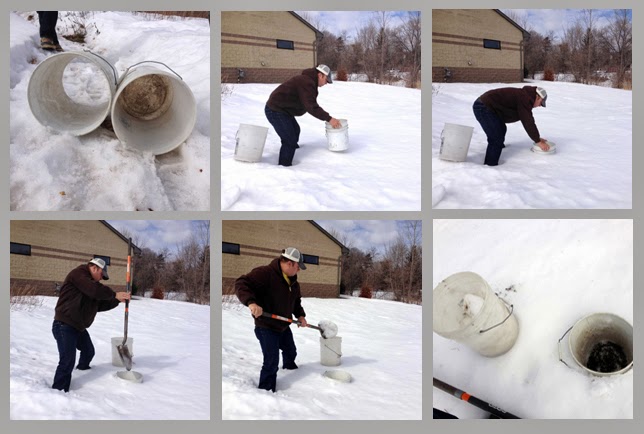 |
| Meghan Manhatton, from St. Paul Parks and Recreation, and Janna, 2013 RWMWD Natural Resources Intern, keep a prescribed burn under control at Lake Phalen. |
Our first controlled burn of natural buffers along the Lake Phalen shore attracted the attention of many passersby, including this older gentleman, a regular lakeside walker. He seemed quite distressed to think that we were destroying all the grasses and flowers we’d planted. When I tried to explain that we wanted to give the prairie a boost, he just shook his head and walked on.
 |
| Lake Phalen's shoreline restorations are periodically burned in the spring or late fall to help new native plant growth. |
The short answer is that prairie ecosystems have developed in a landscape subject to frequent fires, both natural and human-caused. The deep rooted, perennial grasses and flowers that make up this plant community are able to survive and thrive in the presence of regular fires. The longer answer involves the physical and ecological mechanisms natural resource professionals point to when discussing how fires can be beneficial. From the
plant’s perspective, it’s all about temperature, access to sunlight and nutrients, and freedom from competition.
One consequence of a controlled burn is the removal of dead plant material that builds up in a prairie. This increases the amount of sunlight that reaches the ground. Not only is the amount of light increased but the charred earth warms up quickly. This happens because the black ash absorbs every wavelength of visible light. Elevated soil temperatures stimulate both plant growth and soil bacteria.
 |
| Burning dead plant material increases the amount of sunlight reaching new sprouts. |
The combustion of dead plant stems and leaves releases essential nutrients back into the prairie, but the story is a little more involved. Soil microbes actually do the heavy lifting in converting nutrients into forms that the plants can use. Thanks in part to the action of these microbes, burned prairies produce taller, healthier plants with more vigorous flowering. Increased flower production provides sustenance to pollen and nectar consumers. Of course we humans find all those flowers quite attractive as well!
Another benefit of fire is the reduction of competition by unwanted plants. Fire helps to reduce annual weeds, destroying seeds and harming or killing early growing annual plants. Fire can also suppress or even kill some of the undesirable cool season perennial grasses , such as smooth brome and bluegrass. Burns also set back woody vegetation that tends to take over prairies if left unmanaged.
 |
| The Gervais Mill Pond restoration near RWMWD's office is burned every few years to help the native plants thrive. |
With this list of benefits, why don’t we just burn our natural areas every year?
Although burning a prairie is helpful to general prairie health, it is not without other consequences. The downside to spring burns is damage to desirable cool season plants, particularly spring flowers such as pasque flower, prairie smoke, and Jacob’s ladder. And while our larger, mobile critters can get themselves out of harm’s way for the most part, beneficial insects that overwinter in prairie plants typically don’t emerge until later in the spring. The bugs that hunkered down in the area selected for a spring burn will likely perish. To mitigate for these effects we will burn most managed areas every two or three years, and select areas to serve as refuges for vulnerable insect species.
When you see us out around the District this spring with our drip torches and swatters, we want you know we are out to help the prairie, not harm it. Prescribed burns are not just an opportunity for us to don the Nomex “banana suits” – as awesome a fashion statement as that makes – but a management tool to improve the health, habitat value and beauty of our native plantings.



















